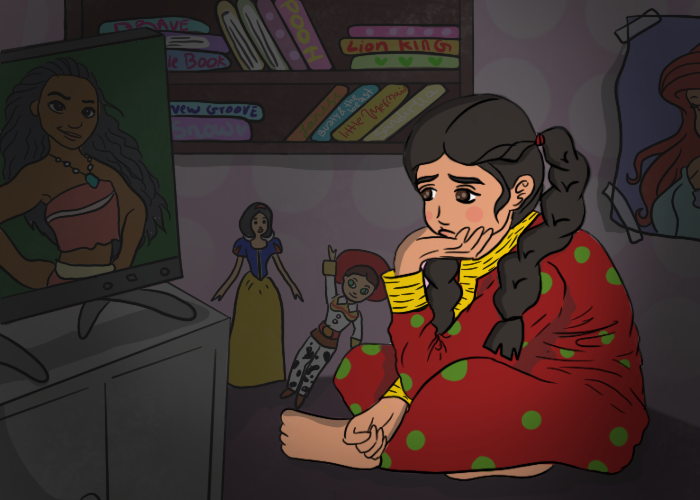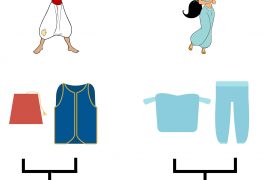Seeing one’s self on screen is critical for children, Emirati children need enough representation for them to grow up with a sense of pride in who they are.

If a group of five-year-old Emirati children was asked to describe a typical doll, their answers wouldn’t vary much. Their answers would be that dolls are usually fair-skinned with Caucasian features (blue or green eyes and silky fair hair). However, these dolls are more than toys for children, they define their perception of beauty. For so long, what was considered beautiful and attractive was defined only by Western perceptions of beauty. Other “races” were excluded from the mainstream media and the fashion industry, which made it difficult to challenge this global perception of beauty.
Until today, it seems like most images from the media and fashion campaigns are constantly reinforcing the idea that the whiter and more westerner one is, the more attractive the person is. A 2018 report has pointed out that Hollywood made no significant progress with ethnic representation since 2007 [1]. And one study has found that exposure to TV shows is linked to lowering the self-esteem of non-caucasian children [2]. Even though the idea of race has no biological evidence, it is still shaping the world we live in.
Disney movies are part of this problem. Until recently, there were only four non-white Disney princesses: Mulan, who is a Chinese princess, Tianna, a black princess, Jasmine, the “Oriental” princess, as well as the Native American princess, Pocahontas. And in the UAE, Arabic children’s TV shows typically made up a small percentage of the total number of shows aired [3]. Most of the shows were produced in the West or in Japan, making the characters’ features un-relatable to the Arab viewers.
Nonetheless, there have been many successful attempts at challenging the domination of these ideas recently. In 2016, Disney introduced the latest addition to their princesses, Moana, who is a Polynesian girl with a dark skin tone. The film also included voice actors of Polynesian descent only, as a way of making the representation of this ethnic group more accurate. Diversity is also found in the new Barbie dolls. The revolutionary change included dolls with various skin tones, eye colors, and facial features.
Similar developments are also taking place in the UAE. One of the new attempts includes the Emirati TV channel Majid. Majid channel airs children shows that feature the beloved characters of Majid magazine, a magazine that generations of Emiratis grew up with since 1979. The channel was well received by the Emirati and Arab children as indicated by the fact that Majid’s YouTube channel has over 190 million views to date. Another important development is the revival of Iftah ya Simsim, the Arabic version of Sesame Street, which was reproduced in the UAE in 2015 after 25 years of hiatus. The show includes Emirati actors, puppeteers, and Emirati children wearing traditional clothes which provide images the children can see themselves and their culture on screen. The show is also committed to producing content that matches the UAE’s cultural values, society, as well as the Arabic customs and Islamic traditions.
Based on these developments, even though the world’s description of beauty has been centered for centuries around European definitions of beauty, the world, and specifically the UAE, has witnessed positive changes with attempts to represent other forms of beauty in children’s media. It is important to support local creators since that can help us be less dependent on major western studios and have positive impacts on how our children view and think about themselves. These attempts, as small as they might seem, can help transform our reality gradually. After all, if a stereotype about the superiority of one race over others was regarded as a universal truth without any scientific evidence, is it really impossible to create a counter-narrative that challenge these ideas?
References
[1] Levin, S. (2018, July 31). Hollywood has made ‘no progress’ in on-screen diversity, report finds. The Guardian. Retrieved from https://www.theguardian.com/culture/
2018/jul/31/hollywood-diversity
-report-usc-no-progress-2017
[2] Martins, N., & Harrison, K. (2011). Racial and Gender Differences in the Relationship Between Children’s Television Use and Self-Esteem. Communication Research, 39(3), 338-357. doi:10.1177/0093650211401376. Retrieved from https://journals.sagepub.com/doi/abs/
10.1177/0093650211401376?journalCode=crxa
[3] Now, Arabic-speaking Majid will enchant through TV. (2015, September 15). Khaleej Times. Retrieved from https://www.khaleejtimes.com/nation/
general/now-arabic-speaking-majid-will-enchant-through-tv



